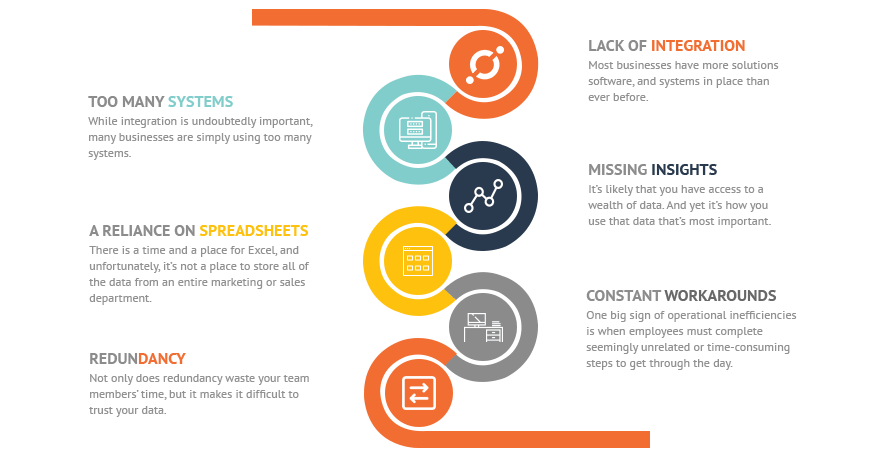Every business has a bottleneck or operational inefficiency that they’d like to fix. But it’s not uncommon for these inefficiencies to be relegated to the bottom of the to-do list where they become part of the status quo.
But what if these inefficiencies are impacting your business more than you first thought? And what if many of them could be solved simultaneously?
Here are some of the most common operational inefficiencies you may be seeing in your business:

Lack of integration
Most businesses have more solutions software, and systems in place than ever before. Unfortunately, many have found that problems are arising because these internal applications and systems don’t ‘communicate’ with each other. This means that employees are dealing with duplicate data entry, incorrect or missing information, and (often) constant frustration.
Integrating your systems will mean that data entered into one will seamlessly transfer to another. This means all departments and employees are working from the same information, and you’re saving them hours of previously lost productivity each week.
Too many systems
While integration is undoubtedly important, many businesses are simply using too many systems. When each department has a separate system and all are juggling the same information, it’s easy to see where problems can begin.
Often, at least one of these systems is legacy software, and other systems have been implemented to overcome the limitations of this software. Unfortunately, these limitations tend to become even more evident over time, while the legacy software itself is a threat to security and hugely expensive to maintain.
Missing insights
It’s likely that you have access to a wealth of data. And yet it’s how you use that data that’s most important. Leaders who don’t have access to real-time data and the most relevant information are unable to make the best possible business decisions.
When your competitors have access to dashboards showing a range of insights in real-time, and you’re only getting half of the picture after the fact, you may quickly find yourself in trouble.
A reliance on spreadsheets
There is a time and a place for Excel, and unfortunately, it’s not a place to store all of the data from an entire marketing or sales department. If your employees are spending hours each week sending and updating spreadsheets, this a is a glaring operational inefficiency.
Not only is this vulnerable to human error, but your employees are likely to resent this drudgery, and could be spending this time doing much more important and valuable tasks.
Constant workarounds
Is it taking your employees an increasingly long time to do tasks that should be routine? It may be a good idea to talk to them about the steps they need to take in order to do complete those tasks.
One big sign of operational inefficiencies is when employees must complete seemingly unrelated or time-consuming steps to get through the day. Time is money, and frustrated employees are more likely to become disengaged or leave your company completely.
Redundancy
Not only does redundancy waste your team members’ time, but it makes it difficult to trust your data. Employees find themselves with multiple, conflicting pieces of information about the same customers, while your company’s reporting and data analytics are unreliable. It’s difficult to focus on innovation and growth when you’re constantly dealing with redundant and incorrect data.
If your business is impacted by any of the above operational inefficiencies, we can help. Get in touch today to learn how automation can fix many of these inefficiencies at the same time.




